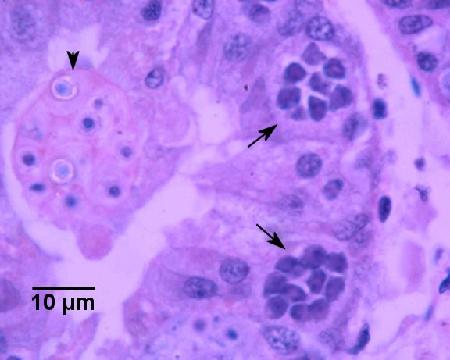Marteilia-like Paramyxea of Australian Flat Oysters
On this page
Category
Category 3 (Host Not in Canada)
Common, generally accepted names of the organism or disease agent
Marteilia-like parasite of flat (angasi) oysters.
Scientific name or taxonomic affiliation
Marteilia-like paramyxean protist. Comparison of the morphology of various stages of this parasite with Marteilia sydneyi from Saccostrea glomerata from New South Wales, Australia, and with the spores and sporogenesis of Marteilia refringens from Ostrea edulis in France and Marteilia sp. from Saccostrea cuccullata from Western Australia (proposed to be M. lengehi (Comps 1976)) using light microscopy suggests that the parasite in Ostrea angasi may be a new species of Marteilia. However further work using transmission electron microscopy and molecular DNA analysis will be required to confirm this suggestion (Heasman et al. 2004). Also, cross reaction with molecular diagnostic tools developed for M. sydneyi (Kleeman et al. 2002a,b) should be assessed.
Geographic distribution
Bermagui and Narooma, New South Wales, Australia.
Host species
Ostrea angasi.
Impact on the host
The parasite was encountered in two oysters during a disease survey of wild O. angasi in southern New South Wales, Australia using standard histopathology techniques. 0ne of 88 oysters from Bermagui had a moderate infection and one of 98 oysters from Narooma had a heavy infection. None of the other oysters, including an additional 288 specimens from three other locations on the southern coast of New South Wales had detectable infections (Heasman et al. 2004).
Diagnostic techniques
Gross Observations
Both infected oysters had pale digestive glands.
Histology
Infected nurse cells were large (mean diameter 14.3 μm, range 9.6-19.2 μm, n = 15) and contained 1 to at least 10 parasite daughter cells (mean 3.8 x 3.5 μm, range 3.2-5.6 x 2.4-4 μm, n = 10) in each plane of section. Sporogenesis was observed in both infected oysters, but was particularly apparent in the heavily infected oyster from Narooma. Up to 14 spore-like bodies (mean 4.5 μm diameter, range 4-4.8μm, n = 10) were observed in sections through sporangiosaurus-like structures within the tubule epithelium. These spore-like structures stained acid fast using Zeihl Neelsen stain.

Figure 1. Three adjacent nurse cells (arrows), one of which contains 5 daughter cells (arrowhead) of the Marteilia-like parasite in the digestive gland epithelium of Ostrea angasi. Haematoxylin and eosin stain. Image provided by Ben Diggles PhD, DigsFish Services, www.digsfish.com, ben@digsfish.com.

Figure 2. Two nurse cells containing daughter cells (arrows) within the digestive gland tubule epithelium and extending into the lumen of the tubule a sporangiosaurus-like structure (arrowhead) in which spore-like structures are developing. Haematoxylin and eosin stain. Image provided by Ben Diggles PhD, DigsFish Services, www.digsfish.com, ben@digsfish.com.

Figure 3. Two sporangiosaurus-like structure containing spore-like bodies (arrows) within the digestive gland epithelium are beside a nurse cell (arrowhead) containing developing daughter cells. Haematoxylin and eosin stain. Image provided by Ben Diggles PhD, DigsFish Services, www.digsfish.com, ben@digsfish.com.
Methods of control
No known methods of prevention or control. Infected oysters should not be transported into areas known to be free of the disease.
References
Comps, M. 1976. Marteilia lengehi n. sp., parasite of the oyster Crassostrea cucullata Born. Revue des Travaux de l'Institut des Pêches Maritimes 40: 347-349. (In French, with English summary).
Heasman, M., B.K. Diggles, D. Hurwood, P. Mather, I. Pirozzi and S. Dworjanyn. 2004. Paving the way for continued rapid development of the flat (angasi) oyster (Ostrea angasi) farming industry in New South Wales. Final Report to the Department of Transport & Regional Services, Project No. NT002/0195 June 2004 NSW Fisheries Final Report Series No. 66. NSW Fisheries, Nelson Bay.
Kleeman, S.N., R.D. Adlard and R.J.G. Lester. 2002a. Detection of the initial infective stages of the protozoan parasite Marteilia sydneyi in Saccostrea glomerata and their development through to sporogenesis. International Journal for Parasitology 32: 767-784.
Kleeman, S.N., F. Le Roux, F. Berthe and R.D. Adlard. 2002b. Specificity of PCR and in situ hybridization assays designed for detection of Marteilia sydneyi and M. refringens. Parasitology 125: 131-141.
Citation Information
Bower, S.M. (2006): Synopsis of Infectious Diseases and Parasites of Commercially Exploited Shellfish: Marteilia-like Paramyxea of Australian Flat Oysters.
Date last revised: August 2006
Comments to Susan Bower
- Date modified: